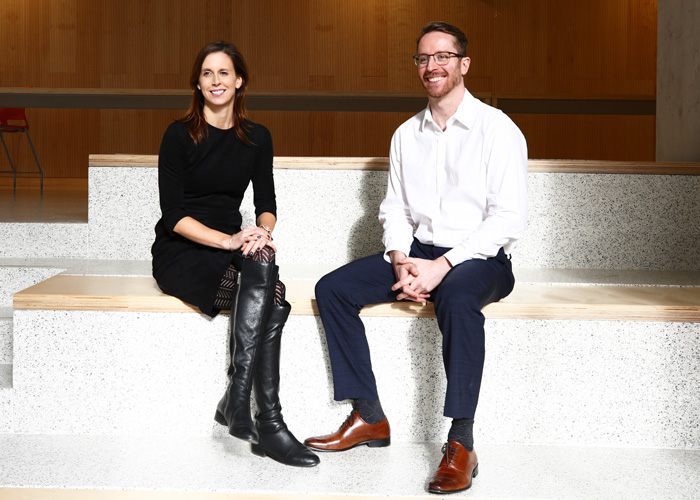
Tapping into the expertise of world-leading researchers is a powerful way for companies to address pressing challenges or gain a competitive edge. Each year U of T Engineering partners with more than 400 external companies and organizations through strategic research collaborations in areas from quantum-inspired computing to sustainable infrastructure.
Allison Brown, director of corporate & foundation partnerships, and Adriano Vissa, associate director of corporate partnerships, help to foster and grow these important connections with industry. They recently sat down with Tyler Irving to discuss how the nature of partnerships is evolving at U of T Engineering.
[wc_divider style=”solid” line=”single” margin_top=”” margin_bottom=”” class=””][/wc_divider]
What makes a successful partnership?
AB: The goals of the researchers and the external collaborators need to be well aligned. That means finding a challenge that is important to a company’s business model, but that also hinges on some fundamental principle in science, engineering or technology.
Addressing this kind of challenge usually requires a time horizon of about three to four years, which lines up pretty well with what a typical graduate student would be able to take on. Often, partners are interested in addressing more complex challenges that would involve multiple students, or multiple research teams. This expands the time horizon and mores the partnership toward a more long-term, strategic approach.
AV: Our job is to be a little bit like sports agents, bringing together the interests of two or more parties and making sure the partnership can deliver value for all involved. We want to address challenges, but we also play a role in terms of strengthening the bench — that is, nurturing talent with the skill set needed to address future challenges.
Can you give an example of a strategic partnership?
AB: Right now, our Faculty is working with Fujitsu on advancing their digital annealer, which is a quantum-inspired computing hardware technology. This is something that could have commercial applications in a number of areas, but it’s unclear which ones will be the most impactful at the start. So, they’ve tapped into our experts in financial technology, health care, and smart cities. They are the ones who can test the digital annealer and determine which challenges it is best suited to address. Those are the avenues that Fujitsu will pursue in the future.
What makes U of T Engineering’s approach unique?
AV: I would say it’s the combination of breadth and depth in research. We’re strong in many different areas, including advanced manufacturing, robotics, autonomous systems, artificial intelligence (AI) and tissue engineering. That’s appealing to many partners, who see us as a one-stop shop for engineering excellence.
What current trends are influencing industry partnerships at U of T Engineering?
AB: One area that’s getting a lot of attention right now is AI. There have been a lot of advances lately, and investment from government and industry is increasing. Engineers are well positioned to apply AI techniques to practical challenges. For example, if you want to use AI to build a smart city, you need someone with the relevant civil engineering expertise, someone that can develop the computer architecture to ensure that the AI algorithms can operate at the right speed, and someone with a strong theoretical understanding of AI. This is what I call “full-stack AI capability.”
Another trend is simply strong growth. The amount of direct industry funding we receive increased by more than a third over the past year, and it’s even higher when you count federal or provincial matching programs. It’s a very exciting time.
What do you expect to see in the next few years?
AB: I think we’ll see a shift toward what we call strategic or comprehensive partnership models. Instead of a one-off project, we’re seeing companies come to us with a much more holistic perspective, with numerous related challenges that extend across multiple departments. Some are establishing innovation funds, which issue calls for proposals on an annual basis. Others have signed co-location agreements, enabling academic and industrial researchers to share space on campus.
AV: We’re also excited about continuing to expand our range of sectors. For example, our Lassonde Institute of Mining is developing a new partnership strategy, and there is lots of interesting work going on in biomedical engineering, which is my own background. I think we have some really unique value to offer potential partners.
AB: More companies are attracted to Toronto as an innovation hub than ever before, and U of T is a key anchor of that reputation. In Thomson Reuters annual rankings of the World’s Most Innovative Universities, we’ve jumped 22 spots in the last two years. I’m excited to see that needle continue to move higher.




